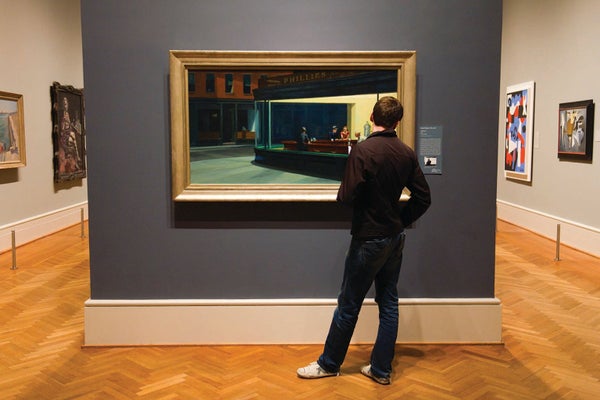If you feel deeply stirred by Edward Hopper's painting Nighthawks but unmoved passing by a real-world diner late at night, it may be because of what's happening inside your body. New research published in Cognition and Emotion suggests that bodily sensations aren't just a by-product of art's emotional impact but a key pathway for experiencing something as “art” in the first place.
In a study involving 1,186 participants and 336 visual art pieces, researchers found that the strength of emotional experience triggered by an artwork correlated with the strength of bodily sensations reported while viewing it. Emotions were measured using subjective reports, and viewers separately marked on a virtual human figure where and how they felt physical sensations. Eye tracking and participant surveys, meanwhile, gauged viewers' interest in the paintings and whether they considered them to be art.
Bodily feelings' magnitude correlated with both the strength of emotional experience and the evaluation of a piece as art. Sensations were most prominent when participants said they felt empathy (the most commonly reported positive emotion) and when they cited “touching” and “moving” emotional experiences.
On supporting science journalism
If you're enjoying this article, consider supporting our award-winning journalism by subscribing. By purchasing a subscription you are helping to ensure the future of impactful stories about the discoveries and ideas shaping our world today.
Negative emotions were uncommon, but reports of “sadness” were also linked to “touching” and “moving” experiences—and to a participant categorizing a work as art. “Even the thrills from a haunted house are ultimately experienced as positive, as we experience our hearts racing while we know we are safe,” says study lead author Lauri Nummenmaa, a researcher at the University of Turku in Finland. “Art likely exploits similar mechanisms for making us feel good. It activates our autonomic nervous system, and in the peace and quiet of an art gallery this increased bodily activity feels good to us.”
The researchers also found the strength of both bodily sensations and emotion was highest for artworks depicting people, dovetailing with the theory that seeing others' actions may trigger sensorimotor mirroring effects. Although the study used only subjective reports and didn't measure objective physiological changes in the body, the data suggest that art perception is an interoceptive process: it involves awareness of the body's internal state. Art may “get under our skin” to shift perception.
“Some forms of art may help subtly shift attention to our bodies, depending on the artistic scene or subject, even to specific regions like the chest or heart,” says neuroscientist Jennifer MacCormack, who leads University of Virginia's Affect & Interoception Lab. This could then influence how much we incorporate the body into our emotional experience, she adds. Previous research has linked aesthetic perception of art to the brain's insular cortex, which mediates interoception. Art may be in the whole body—not just the eye—of the beholder.
